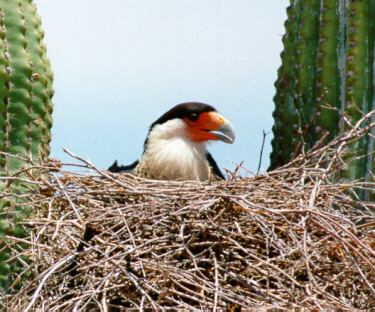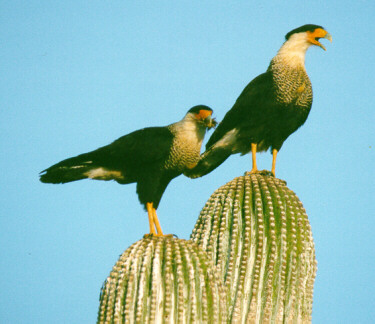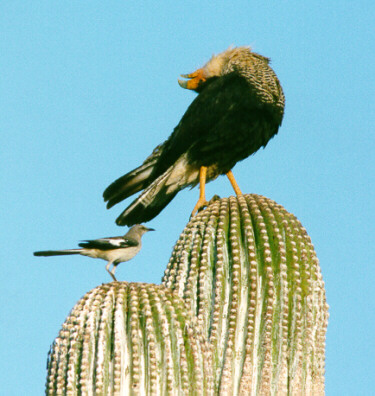Crested Cara Cara Photographs and Sound Recording
Photos by Greg Clark, May 1997 and Earle Robinson, May 1998
 During the Arizona Breeding Bird Atlas survey work in 1997 we found this occupied nest. In 1998 we returned to find that the nest was occupied again. Looking over a huge geographic area in south central Arizona we were only able to find two occupied nests. While searching for nests in 1997 we discovered that used Crested Cara Cara (CC) nests, built in Saguaro, are distinctive and can be identified without the presence of the birds. If you look at the picture to the left you can see the basic construction technique used by the bird. The completed nest has the appearance of an English thatched-roof. The sticks used are very small compared with the sticks used in Red-tail Hawk, Harris' hawk, Common Raven, or Chihuahuan Raven nests. Over the last few years Tim and I have checked hundreds of used nests up in Saguaros. Perhaps because of this experience, when we both saw a used CC nest for the first time we were immediately struck by the thatched-roof appearance and the immense size of the nest. One used nest we found we nick-named the "Volkswagen" nest because it was about the same shape and size of a Volkswagen Beetle car (nestled within several large Saguaro arms in the top of the cactus, and thus able to hold such a large structure together). Over two years we eventually found a number of used nests, and although they all share the thatched-roof look, none could compare in size to the Volkswagen nest. However, all used nests found are large compared to the more common hawk and raven nests. An additional characteristic of nest sites was the open terrain surrounding the nest. All of the nests found were in a solitary Saguaro cactus, as opposed to a Saguaro "forest" where large numbers of cactus are close together. The birds appear to favor a flat flood plain with low density vegetation. One used nest was found in a solitary Saguaro in the middle of an immense flood plain with a dried mud surface stretching for thousands of feet in all directions.
During the Arizona Breeding Bird Atlas survey work in 1997 we found this occupied nest. In 1998 we returned to find that the nest was occupied again. Looking over a huge geographic area in south central Arizona we were only able to find two occupied nests. While searching for nests in 1997 we discovered that used Crested Cara Cara (CC) nests, built in Saguaro, are distinctive and can be identified without the presence of the birds. If you look at the picture to the left you can see the basic construction technique used by the bird. The completed nest has the appearance of an English thatched-roof. The sticks used are very small compared with the sticks used in Red-tail Hawk, Harris' hawk, Common Raven, or Chihuahuan Raven nests. Over the last few years Tim and I have checked hundreds of used nests up in Saguaros. Perhaps because of this experience, when we both saw a used CC nest for the first time we were immediately struck by the thatched-roof appearance and the immense size of the nest. One used nest we found we nick-named the "Volkswagen" nest because it was about the same shape and size of a Volkswagen Beetle car (nestled within several large Saguaro arms in the top of the cactus, and thus able to hold such a large structure together). Over two years we eventually found a number of used nests, and although they all share the thatched-roof look, none could compare in size to the Volkswagen nest. However, all used nests found are large compared to the more common hawk and raven nests. An additional characteristic of nest sites was the open terrain surrounding the nest. All of the nests found were in a solitary Saguaro cactus, as opposed to a Saguaro "forest" where large numbers of cactus are close together. The birds appear to favor a flat flood plain with low density vegetation. One used nest was found in a solitary Saguaro in the middle of an immense flood plain with a dried mud surface stretching for thousands of feet in all directions.
In 1997 the nest site shown in the photograph was the sole domain of the CC. In 1998 the site became much busier. Because of the abundant food supply in 1998, the Northern Mockingbirds were really upset by any intrusion in their territory. The Mockingbirds would chase, harrass, and constantly scold the CC adults around the nest. The recording available to download has both the CC and the Mockingbird scold on the recording. In addition to these birds a Gilded Flicker built a nest in the same cactus. When you listen to the recording it is possible to hear the baby Flickers inside the cactus.
Photo By Earle Robinson, May 1998
 These two photographs show the birds perched on the top of the cactus above the nest (not shown in the photos). In one photo one of the adults is bringing food to the nest. In the other photo the bird has his head laid back onto his back. This is done while the bird calls. The bird starts a call and may finish without laying his head back. However, if he does lay his head back it changes the frequency and duration of the call. There are examples of this in the recording.
These two photographs show the birds perched on the top of the cactus above the nest (not shown in the photos). In one photo one of the adults is bringing food to the nest. In the other photo the bird has his head laid back onto his back. This is done while the bird calls. The bird starts a call and may finish without laying his head back. However, if he does lay his head back it changes the frequency and duration of the call. There are examples of this in the recording.
The original CC sound recording was produced using a Sennheiser MKH70 shotgun microphone and the audio was stored on a 48 ksps DAT using a Tascam DA-P1 digital audio recorder. The recording was down-sampled to 44.1 ksps and converted to MPEG3 to reduce the file size to 430K bytes. This recording is an example of "remote micing". The microphone is placed very close to the nest, on a tripod, and shielded cable is run from the microphone to the tape recorder about 100 feet away. The idea is to give the birds some room. In this case 100 feet wasn't enough. I had to get 300 feet away before the bird would ignore my presence. In these cases you just turn on the tape recorder, set one of the record channels a little lower to be sure you don't saturate the amplifier, and go off to watch and hope the bird comes back and says something. The microphone was about 15 feet from the nest.The recording has has some of the Mockingbird scolds removed to make it shorter for a faster download. Also, blank spots with no bird sounds have been removed for the same reason.
 Calling CC with companion Northern Mockingbird. Photo by Earle Robinson, May 1998.
Calling CC with companion Northern Mockingbird. Photo by Earle Robinson, May 1998.
download mpeg3 recording (cc_mb2.mp3)
Copyright Greg Clark, 1999
View CC Babies In Nest -- Crested Cara Cara baby photographs, nest, and adult with snake and Mockingbird
update 8/2012